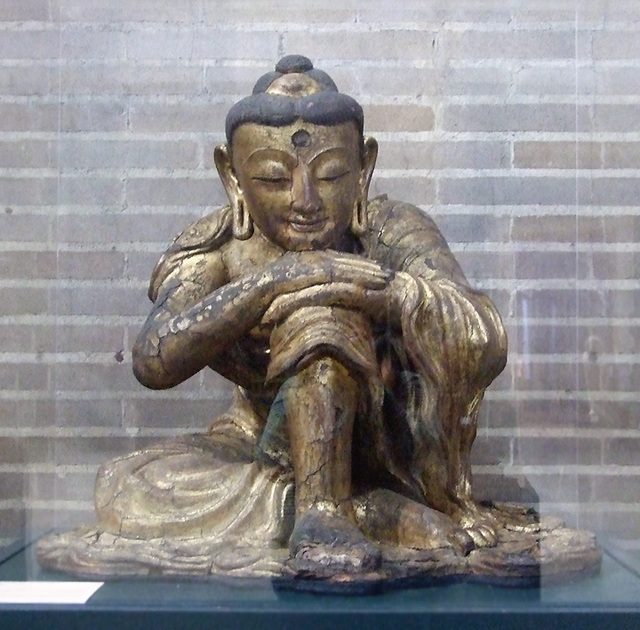Guanyin in the University of Pennsylvania Museum,…
Head of a Bodhisattva in the University of Pennsyl…
Chinese Model of a House in the University of Penn…
Chinese Model of a Pig Pen in the University of Pe…
Detail of a Statue of Guanyin in the University of…
Statue of Guanyin in the University of Pennsylvani…
Chinese Death Mask in the University of Pennsylvan…
Head from a Terracotta Sarcophagus in the Universi…
Etruscan Model Brazier Set in the University of Pe…
Etruscan Sarcophagus with a Reclining Man in the U…
Etruscan Bronze Bell Helmet in the University of P…
Etruscan Negau Helmet in the University of Pennsyl…
Etruscan Jockey Cap Helmet in the University of Pe…
Faun with a Wineskin in the University of Pennsylv…
Marble Funeral Portrait of a Middle-Aged Man in th…
Attic Pentelic Marble Grave Stele in the Universit…
Opus Alexandrinum Mosaic in the University of Penn…
Egyptian Predynastic Burial Reconstruction in the…
Lintel of Hatshepsut and Thutmosis III in the Univ…
Isis Nursing Horus in the University of Pennsylvan…
Stele of Nefersekekhy in the University of Pennsyl…
Seated Man in the University of Pennsylvania Museu…
Head of a King in the University of Pennsylvania M…
Sumerian Male Statue in the University of Pennsylv…
Peg with a Human-Faced Bull Protome in the Univers…
Peg with a Human-Faced Bull Protome in the Univers…
Alabaster Statue from Khafaje in the University of…
Sumerian Statue of a Man in the University of Penn…
Silver Spouted Jug in the University of Pennsylvan…
Bull Head from the Sound Box of a Lyre in the Univ…
Sumerian Electrum Tumbler in the University of Pen…
Sumerian Helmet in the University of Pennsylvania…
Sumerian Helmet in the University of Pennsylvania…
Harp Ornament in the University of Pennsylvania Mu…
Sumerian Gold Wreath in the University of Pennsylv…
Sumerian Choker in the University of Pennsylvania…
Sumerian Gold Bowl in the University of Pennsylvan…
Sumerian Gold Bowl in the University of Pennsylvan…
Sumerian Gold Earrings in the University of Pennsy…
Sumerian Vessel in the Form of an Ostreich Egg in…
Sumerian Female Statue Fragment in the University…
Sumerian Alabaster Cosmetic Box in the University…
Model Shrine in the University of Pennsylvania Mus…
Offering Stand from Beth Shean in the University o…
Marble Portrait of Agrippina the Elder in the Univ…
Location
Keywords
Authorizations, license
-
Visible by: Everyone -
All rights reserved
-
333 visits
Sakyamuni Buddha in the University of Pennsylvania Museum, November 2009


Sakyamuni Buddha
China
Dry lacquer
Yuan Dynasty (1279-1368)
#C 405
Sakyamuni was the historical founder of Buddhism who lived between 563 and 483 BC. He is seated in meditation.
The dry lacquer technique was first used in China during the Six Dynasties period (AD 220-581). It was later revived in the 14th century under the influence of Li Yuan, a Chinese sculptor who studied in Nepal. Layers of cloth soaked in lacquer were built up over a temporary clay core to create a durable yet lightweight hollow image which could be easily carried in processions. This technique and the Nepalese facial characteristics suggest Li Yuan’s influence.
Sacred items were often placed in the inferior cavities of Buddha images to increase the potency of the image. Five Buddhist sutras, or texts, were found inside this image, four in Chinese and one in Tibetan. The Tibetan text dates from around AD 1200, while a woodblock print illustration from one of the Chinese texts is from the late 14th century.
Text from the U. Penn. Museum label
Translate into English
China
Dry lacquer
Yuan Dynasty (1279-1368)
#C 405
Sakyamuni was the historical founder of Buddhism who lived between 563 and 483 BC. He is seated in meditation.
The dry lacquer technique was first used in China during the Six Dynasties period (AD 220-581). It was later revived in the 14th century under the influence of Li Yuan, a Chinese sculptor who studied in Nepal. Layers of cloth soaked in lacquer were built up over a temporary clay core to create a durable yet lightweight hollow image which could be easily carried in processions. This technique and the Nepalese facial characteristics suggest Li Yuan’s influence.
Sacred items were often placed in the inferior cavities of Buddha images to increase the potency of the image. Five Buddhist sutras, or texts, were found inside this image, four in Chinese and one in Tibetan. The Tibetan text dates from around AD 1200, while a woodblock print illustration from one of the Chinese texts is from the late 14th century.
Text from the U. Penn. Museum label
- Keyboard shortcuts:
Jump to top
RSS feed- Latest comments - Subscribe to the comment feeds of this photo
- ipernity © 2007-2024
- Help & Contact
|
Club news
|
About ipernity
|
History |
ipernity Club & Prices |
Guide of good conduct
Donate | Group guidelines | Privacy policy | Terms of use | Statutes | In memoria -
Facebook
Twitter

Sign-in to write a comment.